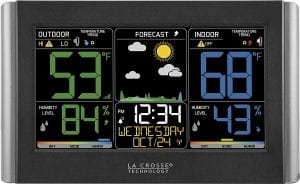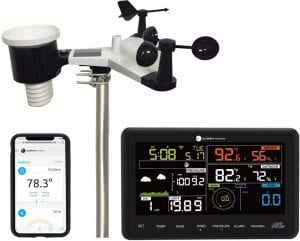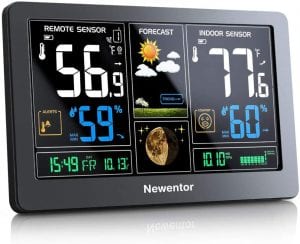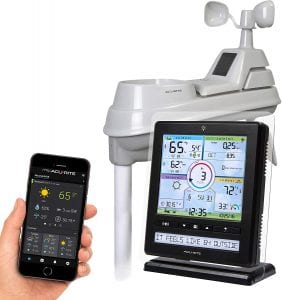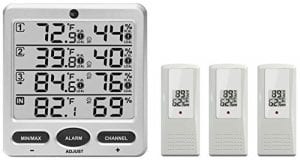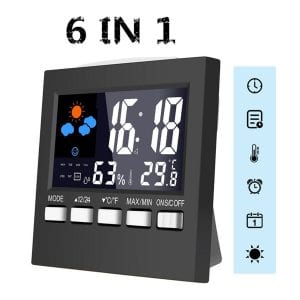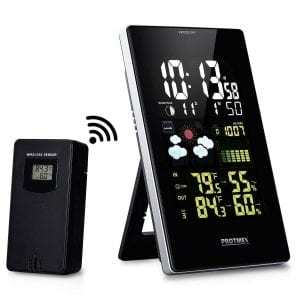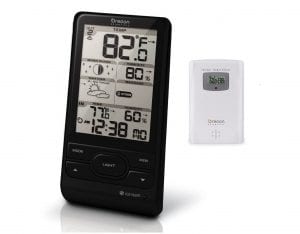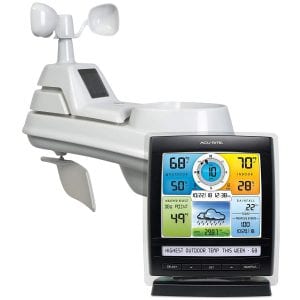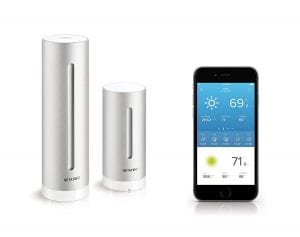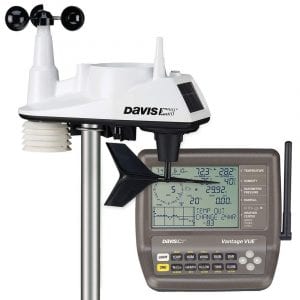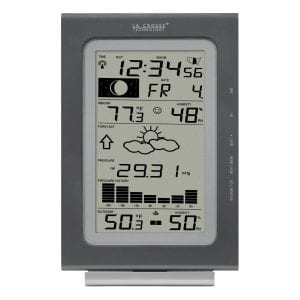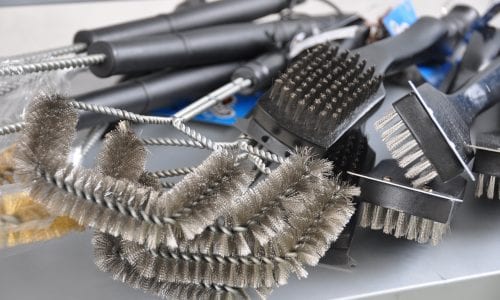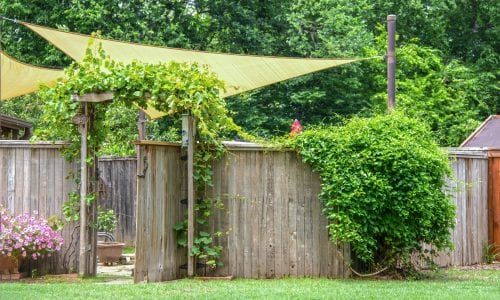The Best Weather Station
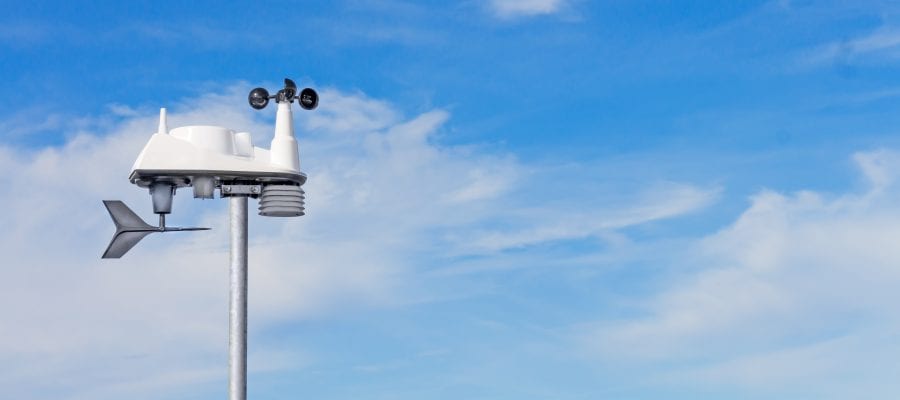
Our Review Process
Don't Waste Your Money is focused on helping you make the best purchasing decision. Our team of experts spends hundreds of hours analyzing, testing, and researching products so you don't have to. Learn more.
Our Picks For The Top Weather Stations
- 1. La Crosse Technology C85845-1 Color Wireless Forecast Weather Station
- 2. Ambient Weather WS-2902B WiFi Smart Weather Station
- 3. Newentor Adjustable Color Display Digital Atomic Clock & Weather Station
- 4. AcuRite 01536 Wireless 5-1 Sensor Home Weather Station
- 5. Ambient Weather WS-10 Wireless Weather Station
- 6. PATHONOR Upgrade Digital Temperature Hygrometer Weather Station
- 7. Protmex EM3352C Wireless Digital Weather Station
- 8. Oregon Scientific Advanced Wireless Weather Station
- 9. AcuRite 01512 Wireless Weather Station with 5-In-1 Weather Station
- 10. Netatmo Wireless Outdoor Sensor Weather Station
- 11. Davis Instruments Vantage Vue Wireless Weather Station
- 12. La Crosse WS-9037U-IT Atomic Forecast Weather Station
You'll enjoy monitoring the weather from this weather station, as the display screen uses a variety of fun colors. Users can adjust the backlight to their liking and mount the unit on any wall. At a glance, you'll be able to identify the forecast, check the time and review the indoor and outdoor temperatures.
Comes in ColorWith this weather station, you'll be able to view the forecast in color and in pictures.
This weather station allows you to monitor the conditions inside and outside of your home from just about anywhere. It uses a color display that is easy to read and has a sensor that reaches 100 feet in most conditions and 330 feet in open air. Just a few of the conditions this unit measures include wind speed, wind direction, rainfall, indoor and ...
Enhanced Wi-Fi ConnectabilityThanks to this weather station's enhanced Wifi connectable option, you'll be able to check on the forecast from your smartphone or tablet.
This weather station comes with three sensors, so you can monitor the weather conditions in three separate areas. The large LCD display includes the moon's current phase, as well as the temperature, humidity level, barometric pressure level, date and time. The receiver can be charged using the included DC adapter or a set of AA batteries.
Customizable AlertsIn addition to including all the features of a traditional weather station, this unit is also outfitted with an alarm clock.
Not only will you be able to check your current forecast with this weather station, but you'll also be able to review your weather history. The unit comes with a 5-in-1 sensor that connects wirelessly to your indoor display. From the display, you'll be able to check the temperature, humidity, wind speed, wind direction and total rainfall amounts.
Real-Time Weather TickerThis weather station is equipped with a real-time weather ticker to provide accurate readings that are easy to understand.
Buying Guide
If you’ve ever seen rain gauges in a person’s yard, you probably know that tracking weather trends is a popular hobby. Today, we have access to all the data we could ever want online, but there’s still no replacement for gathering the data yourself.
Along with technology, weather data collection has gotten more sophisticated with time. Today’s weather stations use sensors and display screens to provide real-time information about the weather in your area. Some even use advanced analytics to help you make sense of the information you’re gathering.
If you’re choosing a weather station, you first need to decide the information you hope to monitor. Some units gather data on everything from wind direction to barometric pressure. You’ll also find some weather stations monitor temperature information both inside your home and outside to help you collect important indoor information like humidity levels.
When you start shopping, you may wonder why some weather stations are so affordable, while others hit the top of your budget. It’s important to pay close attention to the features those more expensive models offer that you can’t get with a cheaper one. You’ll also notice that some less expensive weather stations require you to buy additional sensors to get the most out of the unit.
Smartphone compatibility is an add-on that will matter to some of today’s consumers. Having your weather station connected to your mobile device can be useful if you want to keep track of weather back home while you’re on the road. Some weather stations can also be controlled by Alexa, which is a consideration if you have a smart speaker in your home.
Lastly, it’s important to find a weather station that will remain connected and reliable when you need it most. Make sure you won’t later discover that you can’t get the information you need as a major storm surrounds your house due to a drop in transmission. Since many weather stations rely on your home Wi-Fi, it’s also important to consider whether your Wi-Fi remains up and stable during storms before investing in a weather station.
What to Look For
- Before technology transformed weather collection tools, you were limited in what you could learn. Today’s weather stations build in all the hardware you need to gather information on the weather that will impact you. There are still some features that set one weather station apart from another.
- Chances are, you want more detail than what you can see by looking out your own window. The Ambient Weather WiFi Smart Weather Station has instruments that measure temperature, humidity, wind speed, wind direction, UV and solar radiation and rainfall.
- For data on both your indoor and outdoor environment, consider the Newentor Digital Atomic Weather Station. This unit will help you monitor what’s going on inside your home, as well as outside.
- Weather stations can vary dramatically in their sensitivity, so keep that in mind when comparing prices.
- You’ll find prices vary dramatically from one weather station to another, depending on the features offered with the weather station.
- When considering cost, it’s important to note what each model comes with. Some more expensive models ship with everything you need to get started, whereas others require you to make additional purchases.
- Check to see what is included with your weather station. Some units come with a 5V DC adapter, while others are powered by the sun. If your station uses batteries, they may or may not be included.
- Keep in mind that some weather stations have more basic features that are best used indoors, such as an alarm clock and date and time displays.
- Some lower-priced weather stations ship with three sensors. Their console can read up to eight different locations, but you’ll need to buy five additional sensors to do so. Each additional sensor is available for an affordable price.
- The reach of your weather station is also worth noting. The Ambient Weather WiFi Smart Weather Station has a reach of 100 feet to each sensor.
- Weather stations are meant to monitor weather, so it won’t be much help if your connectivity drops when storms are brewing outside.
- Look for a weather station with a bright display that provides information in an easy to read format. Some have attractive backlights that not only improve readable, but their also voice-activated.
- Smartphone compatibility is also a consideration. The AcuRite Wireless 5-1 Sensor Home Weather Station connects to your favorite mobile device, which means you can get weather information from home even when you’re away.
More to Explore
What’s the point of a smart weather station?
These days, our world is populated with smart devices. You can get smartphones, smart home devices, smart TVs — and now, smart weather stations. For the uninitiated, a smart weather station takes your typical weather forecasting app to a whole new level. CNET describes a smart weather station “as a set of new senses for your home.”
These devices use sensors to give you real-time information about the exact weather conditions in your area. They can monitor temperature, wind direction and speed, air pressure, UV levels, humidity, precipitation and more. Some weather stations can be connected with other devices in your home, meaning you can turn lights on or off or adjust your thermostat based on the input you receive. Or you can have your smart weather station do it automatically.
Smart weather stations can also help you avoid major headaches and expenses associated with problems due to extreme weather conditions. For example, when sub-zero temperatures hit, you can program your device to let you know right away so you can take action to prevent your pipes from freezing. Get an alert when high winds are in the forecast, so you can secure your patio furniture in time before it’s blown away. Determine if your pets need to be taken inside due to heat and humidity.
Another advantage of smart weather stations is that they provide you with a hyper-local forecast. Did you ever talk to a friend across town and realize it’s not raining where they are while a storm passes over your house? With a smart weather station, you can get personalized forecasts based on data straight from your own backyard, making for more accurate predictions.
If you’re a true weather nerd, you can also start to analyze data trends to make decisions for the future. For example, after tracking daily rainfall, you can decide how often you actually need to water the plants in your garden.

